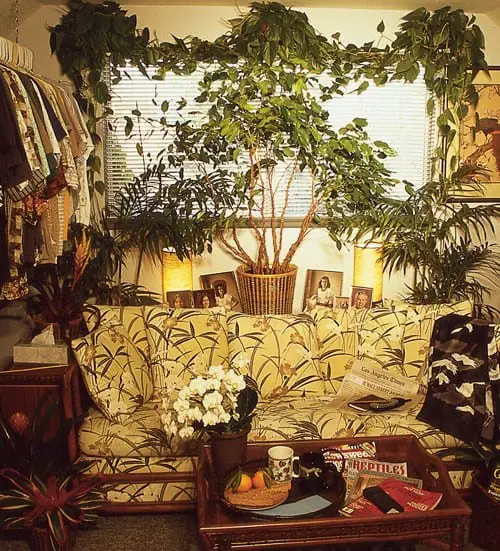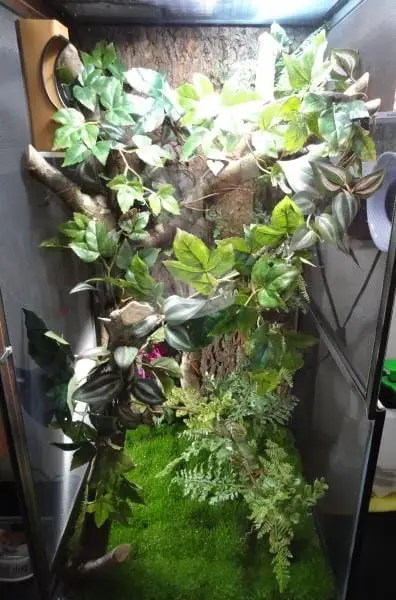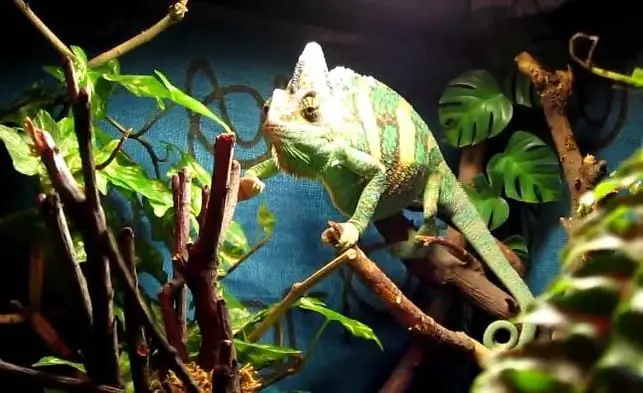Chameleons are some of the most delightful pets known to mankind. They are arguably the most popular pet reptiles in the exotic pet trade because they are visually amazing, and they make for great companions in the house. On top of that, they are not as difficult to take care of as some of the other types of pet reptiles on the market. Beginners and intermediate owners alike will find it a bit easy to take care of this amazing pet reptile.
But, even though chameleons may not be the most difficult pets to take care of, you still need to make sure that you do your fair share when you are taking care of them. And when you are giving them all of the care they deserve, nothing spells “I love my chameleon” more than a habitat that was designed to give the chameleon a comfortable lifestyle. So, if you want to have a chameleon that his happy, healthy, and thriving, you may want to consider building a habitat designed especially for this lovely and adorable pet reptile.
Why build instead of buying?

At this point, you might be asking why there is an actual need for you to build a chameleon cage instead of buying one in the store. After all, there are plenty of stores that sell pre-made reptile cages and terrariums so that you no longer have to make one yourself. But there are a lot of good reasons why you might want to consider constructing a new habitat for your chameleon instead of going to the store to get a pre-made terrarium or cage.
· Some people don’t live close to reptile specialty stores
Not everyone lives close enough to a reptile specialty store to buy a pre-made reptile habitat. However, everyone lives close to a store that sells the materials you need to construct a reptile habitat for your chameleon. In that case, why drive for hours just to get to the closest reptile store when you can just simply construct one with materials you can purchase just about anywhere?
· Pre-made reptile habitats are not designed for chameleons
There are plenty of similarities between other reptile species and chameleons. However, in the same vein, they also have a lot of differences. As such, just because a pre-made reptile habitat in the store was made for reptiles, it does not mean that it is the most suitable cage you can provide for your chameleons. We are not only talking about the shape of the cage but also its size as well as the materials used. Chameleons also have specialized needs when it comes to the type of habitat they require. As such, you just cannot always simply rely on a pre-made reptile habitat you can get from a store.
· You can specify the size and orientation of habitat depending on your chameleon
The chameleon is a varied type of reptile in the sense that there are plenty of chameleon species in the world. All of those different species differ in size, needs, and personality. As such, you might want to consider constructing a habitat that actually suits your chameleon. There might be some stores that carry suitable pre-made reptile habitats, but there is nothing better than the one you specifically designed to fit the needs of your chameleon.
· You can choose the materials you want
A lot of the reptile habitats you can find in pet stores are streamlined in the sense that they basically look the same and are all made of the same materials but are of different sizes. All you have to do is to pick a terrarium that basically fits the size of your chameleon, and then you are done. However, most of those terrariums are made of clear acrylic or glass that are both inefficient when it comes to airflow because of how such materials do not easily allow air to pass through. In that case, constructing a habitat for your chameleon allows you to make use of materials you believe can give your pet a better and more comfortable living condition. On top of that, you can also choose the most durable materials while also making sure that everything is within your budget.
· You are going to learn more about your pet along the way
When you are constructing your chameleon’s new home, it is also a personal journey on your part because of how you will need to know more about this pet reptile for you to understand what kind of a home it needs for it to stay happy and healthy. You will find yourself going online to read reptile forums and checking articles written specifically about chameleons and how to take care of them properly. After all, you should always start constructing a home for your chameleon by learning more about this reptile so that you will know the best kind of environment to provide it.
Building a Habitat for Your Chameleon

Step 1: Know what type of cage or habitat you want to construct
You have a choice of using a cage or a terrarium-type habitat or an open-space habitat. The choice really depends on your preference, where you live, and the type of climate in your region.
Cage or terrarium-type habitats are great for when you want to give your chameleon a safe and secure habitat because you can be sure that they will always be inside their habitat unless they suddenly learn how to open it or jump out of it. On top of that, cage-type habitats are good for whenever you have a limited space to house your chameleon. So, if you happen to live in a small apartment or if your house is full of things, you might want to use a cage-type habitat to save space.
Open-space habitats are basically just large yet enclosed open spaces that you reserved specifically for your pet chameleon. You make one by providing a vacant room for your chameleon or by enclosing an area for your pet right in your backyard. The good thing about an open-space habitat is that it dispenses the need for you to do some actual construction, and it allows your chameleon to feel free to roam around its environment. However, this type of habitat is not as safe as a cage-type because there will always be a risk that your chameleon might find some open space to escape through or that potential predators might attack your pet. And when you are thinking about housing your pet chameleon outdoors, you are not only taking into consideration the predators and the safety risks but also the climate.
Step 2: Choose the materials for your cage
When you decided to go for a cage-type habitat for your pet chameleon, you also have to decide on the materials you want to use for the cage.
- Screen
Screen-type cages make use of different types of screens as the main material used for constructing the entire cage. You can use a metal sheet screen or mesh or maybe even nylon when you are constructing a screen-type cage. The reason why you may want to go for a cage made out of this material is that there are certain species of chameleons that prefer to be housed in an environment with adequate airflow. The screened walls of this cage will allow air to pass through well enough to provide the ventilation that your chameleon needs.
The downside to this type of cage is that it won’t be as sturdy as solid-type cages. Moreover, there is also a need for you to construct a frame to wrap the screen or mesh around as such materials won’t be able to stand on their own. And if the holes on the screens are wide enough, there is a chance that your reptile might catch a toe or two in those holes.
- Plastic or wood
Plastic or maybe even wood can be excellent materials to use for constructing a cage for your chameleon. That is because plastic and wood are sturdy enough that you no longer have to build a separate frame to hold them in place except if the cage you are planning is simply too large. All you have to do is to cut out panels according to the size that you want for your chameleon’s cage and then put them together using some sort of adhesive material. You can also drill in holes to provide the airflow your chameleon needs. However, such cages won’t be as well ventilated as screen cages are.
- Glass or acrylic
Most of the pre-made cages you will see in pet stores are made of glass or acrylic. These materials are see-through so that you will be able to observe your chameleon and so that your reptile will also be able to inspect its immediate environment. Using such materials will require skill and experience on your part because of how you need to be precise in cutting glass or acrylic.
While the ones you see sold in stores lack frames, you can actually construct a frame for your glass or acrylic cages to make them more durable. Wood and metal are good choices for the cage’s frame. Attaching the glass or acrylic to the frame or to one another will require you to use silicone glue to seal the edges. You may also want to drill holes for ventilation. However, since glass and acrylic are easier to break compared to plastic or wood, you need to be skilled when you are drilling holes through this material. That said, we don’t really recommend that you construct a glass or acrylic cage unless you are already skilled and experienced in that endeavor.


